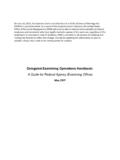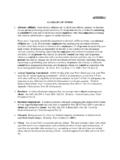Transcription of State Operations Manual
1 State Operations Manual appendix Z- Emergency Preparedness for All Provider and Certified Supplier Types Interpretive Guidance Table of Contents (Rev. 200, Issued: 02-21-20) Transmittals for appendix Z , Condition of Participation for Religious Nonmedical Health Care Institutions (RNHCIs) , Condition for Coverage for Ambulatory Surgical Centers (ASCs) , Condition of Participation for Hospices , Requirement for Psychiatric Residential Treatment Facilities (PRTFs) , Requirement for Programs of All-Inclusive Care for the Elderly (PACE) , Condition of Participation for Hospitals , Requirement for Transplant Programs , Requirement for Long-Term Care (LTC) Facilities , Condition of Participation for Intermediate Care Facilities for Individuals with Intellectual Disabilities (ICF/IID) , Condition of Participation for Home Health Agencies (HHAs) , Condition of Participation for Comprehensive Outpatient Rehabilitation Facilities (CORFs) , Condition of Participation for Critical Access Hospitals (CAHs)
2 , Conditions of Participation for Clinics, Rehabilitation Agencies, and Public Health Agencies as Providers of Outpatient Physical Therapy and Speech-Language Pathology Services , Condition of Participation for Community Mental Health Centers (CMHCs) , Condition of Participation for Organ Procurement Organizations (OPOs) , Conditions for Certification for Rural Health Clinics (RHCs) and Conditions f or Coverage for Federally Qualified Health Centers (FQHCs) , Condition for Coverage for End-Stage Renal Disease (ESRD) Facilities Introduction (Rev. 186, Issued: 03-04-19, Effective: 03-04-2019, Implementation: 03-04-2019) The Medicare and Medicaid Programs; Emergency Preparedness Requirements for Medicare and Medicaid Participating Providers and Suppliers Final Rule (81 FR 63860, Sept. 16, 2016) ( Final Rule ) establishes national emergency preparedness requirements for participating providers and certified suppliers to plan adequately for both natural and man-made disasters, and coordinate with Federal, State , tribal, regional and local emergency preparedness systems.
3 The Final Rule also assists providers and suppliers to adequately prepare to meet the needs of patients, clients, residents, and participants during disasters and emergency situations, striving to provide consistent requirements across provider and supplier-types, with some variations. The new emergency preparedness Final Rule is based primarily off of the hospital emergency preparedness Condition of Participation (CoP) as a general guide for the remaining providers and suppliers, then tailored based to address the differences and or unique needs of the other providers and suppliers ( inpatient versus out-patient providers). The requirements are focused on three key essentials necessary for maintaining access to healthcare during disasters or emergencies: safeguarding human resources, maintaining business continuity, and protecting physical resources. The interpretive guidelines and survey procedures in this appendix have been developed to support the adoption of a standard all- hazards emergency preparedness program for all certified providers and suppliers while similarly including appropriate adjustments to address the unique differences of the other providers and suppliers and their patients.
4 Successful adoption of these requirements will enable all providers and suppliers wherever they are located to better anticipate and plan for needs, rapidly respond as a facility, as well as integrate with local public health and emergency management agencies and healthcare coalitions response activities and rapidly recover following the disaster. Because the individual regulations for each specific provider and supplier share a majority of standard provisions, we have developed this appendix Z to provide consistent interpretive guidance and survey procedures located in a single document Unless otherwise indicated, the general use of the terms facility or facilities in this appendix refers to all provider and suppliers addressed in the Final Rule and in this appendix . Additionally, the term patient(s) within this appendix includes patients, residents and clients unless otherwise stated.
5 Finally, as some specific citations between providers vary, but the language is the same, we have inserted the citation to reflect as [(z) or (y), (x)] as the only the citation number varies by provider or supplier type. Survey Protocol These Conditions of Participation (CoP), Conditions for Coverage (CfC), Conditions for Certification and Requirements follow the standard survey protocols currently in place for each facility type and will be assessed during initial, revalidation, recertification and complaint surveys as appropriate. Compliance with the Emergency Preparedness requirements will be determined in conjunction with the existing survey process for health and safety compliance surveys or Life Safety Code (LSC) surveys for each provider and supplier type. IMPORTANT NOTE: Unless otherwise indicated, the general use of the terms facility or facilities in this appendix refers to all provider and suppliers addressed in this appendix .
6 This is a generic moniker used in lieu of the specific provider or supplier noted in the regulations. For varying requirements, the specific regulation for that provider/supplier will be noted as well. This appendix annotates under the Interpretive Guidelines sections for which providers or suppliers the specific standard does not apply to, unless the standard only applies to one provider or supplier type. Definitions Emergency/Disaster: An event that can affect the facility internally as well as the overall target population or the community at large or community or a geographic area. Emergency: A hazard impact causing adverse physical, social, psychological, economic or political effects that challenges the ability to respond rapidly and effectively. It requires a stepped-up capacity and capability (call-back procedures, mutual aid, etc.) to meet the expected outcome, and commonly requires change from routine management methods to an incident command process to achieve the expected outcome (see disaster for important contrast between the two terms).
7 Reference: Assistant Secretary for Preparedness and Response (ASPR) 2017-2022 Health Care Preparedness and Response Capabilities Document (ICDRM/GWU Emergency Management Glossary of Terms) (November 2016). Disaster: A hazard impact causing adverse physical, social, psychological, economic or political effects that challenges the ability to respond rapidly and effectively. Despite a stepped-up capacity and capability (call-back procedures, mutual aid, etc.) and change from routine management methods to an incident command/management process, the outcome is lower than expected compared with a smaller scale or lower magnitude impact (see emergency for important contrast between the two terms). Reference: Assistant Secretary for Preparedness and Response (ASPR) 2017-2022 Health Care Preparedness and Response Capabilities Document (ICDRM/GWU Emergency Management Glossary of Terms) (November 2016).
8 Emergency Preparedness Program: The Emergency Preparedness Program describes a facility s comprehensive approach to meeting the health, safety and security needs of the facility, its staff, their patient population and community prior to, during and after an emergency or disaster. The program encompasses four core elements: an Emergency Plan that is based on a Risk Assessment and incorporates an all hazards approach; Policies and Procedures; Communication Plan; and the Training and Testing Program. Emergency Plan: An emergency plan provides the framework for the emergency preparedness program. The emergency plan is developed based on facility- and community-based risk assessments that assist a facility in anticipating and addressing facility, patient, staff and community needs and support continuity of business Operations . All-Hazards Approach: An all-hazards approach is an integrated approach to emergency preparedness that focuses on identifying hazards and developing emergency preparedness capacities and capabilities that can address those as well as a wide spectrum of emergencies or disasters.
9 This approach includes preparedness for natural, man-made, and or facility emergencies that may include but is not limited to: care-related emergencies; equipment and power failures; interruptions in communications, including cyber-attacks; loss of a portion or all of a facility; and, interruptions in the normal supply of essentials, such as water and food. Planning for using an all-hazards approach should also include emerging infectious disease (EID) threats. Examples of EIDs include Influenza, Ebola, Zika Virus and others. All facilities must develop an all-hazards emergency preparedness program and plan. Facility-Based: We consider the term facility-based to mean the emergency preparedness program is specific to the facility. It includes but is not limited to hazards specific to a facility based on its geographic location; dependent patient/resident/client and community population; facility type and potential surrounding community assets- rural area versus a large metropolitan area.
10 Risk Assessment: The term risk assessment describes a process facilities use to assess and document potential hazards that are likely to impact their geographical region, community, facility and patient population and identify gaps and challenges that should be considered and addressed in developing the emergency preparedness program. The term risk assessment is meant to be comprehensive, and may include a variety of methods to assess and document potential hazards and their impacts. The healthcare industry has also referred to risk assessments as a Hazard Vulnerability Assessments or Analysis (HVA) as a type of risk assessment commonly used in the healthcare industry. Full-Scale Exercise: A full scale exercise is an Operations -based exercise that typically involves multiple agencies, jurisdictions, and disciplines performing functional (for example, joint field office, emergency operation centers, etc.)













